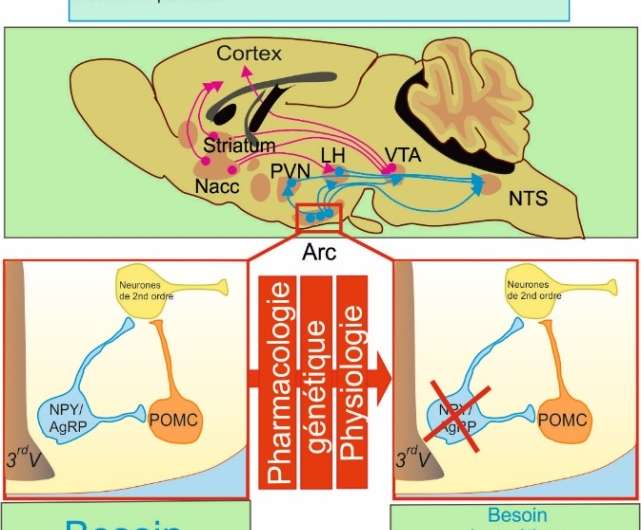Food intake, a fragile balance between neural pathways

A team at the Laboratoire biologie fonctionnelle et adaptative (CNRS/Université Paris Diderot) investigated the relative role of energy needs and "pleasure" of eating in food intake. The researchers studied a group of neurons in mice. They observed that when the neuron activity is compromised, feeding behavior becomes less related to the body's metabolic needs and more dependent on food palatability. These results could explain how ever easier access to appetizing foods may contribute to compulsive eating disorders and favor obesity. This work has just been published in Cell Metabolism.
Feeding behavior is regulated by various nerve pathways, so the need to eat is driven by both the body's energy needs and by the pleasure associated with food. In today's context where energy-rich food is more and more present in our diets and where pathologies such as obesity, diabetes and heart disease are on the increase, it is important to elucidate how these different neural circuits are involved and connected. Understanding the respective contributions of the mechanism that maintains energy balance and the reward (or pleasure) circuit would make it possible to develop more effective treatments for these diseases.
A research team investigated a group of neurons in the hypothalamus called NPY/AgRP, which are known to play a role in food intake. These neurons are part of the circuit that maintains energy balance: they promote food intake when they are activated, in case of fasting or hypoglycemia for example. Until now they have been considered as key targets for developing obesity treatments. By studying mice lacking these neurons, the researchers have demonstrated that these are essential for triggering food intake when the food does not have high hedonic value and is simply a response to metabolic needs. By contrast, they contribute less to food intake when the food is very palatable, high in fats and carbohydrates.
When these neurons are absent or inhibited, the mice consume less standard food, even after fasting. By contrast, they will feed normally if given high-fat and high-carbohydrate food. A series of experiments showed that when NPY/AgRP neuron activity is compromised, the hormone that stimulated them will instead activate neurons involved in the reward circuit. This dopamine-controlled nerve pathway therefore takes over and directs feeding behavior. The result is a disturbed feeding pattern, disconnected from the body's energy needs and essentially dependent on the pleasure caused by food.
The mice studied then ate high-fat and high-carbohydrate foods in higher quantities and gained weight. Their feeding behavior was also much more sensitive to external factors such as stress. Overall, these mice are a good model of comfort feeding.
The mice in this study underwent genetic intervention to alter NPY/AgRP neuron activity. Continued exposure to an energy-rich diet could have similar consequences, causing these neurons to be desensitized and a different driver to replace them: the reward circuit. The resulting eating habits, unrelated to metabolism, contribute to the onset of compulsive disorders and favor obesity. These results therefore shed new light on the role of NPY/AgRP neurones in maintaining energy balance. They also indicate that acting at a pharmacological level on these neurons to treat hyperphagia could be counter-productive.
More information: "Palatability Can Drive Feeding Independent of AgRP Neurons." Cell Metab. 2015 Aug 12. pii: S1550-4131(15)00340-X. DOI: 10.1016/j.cmet.2015.07.011















